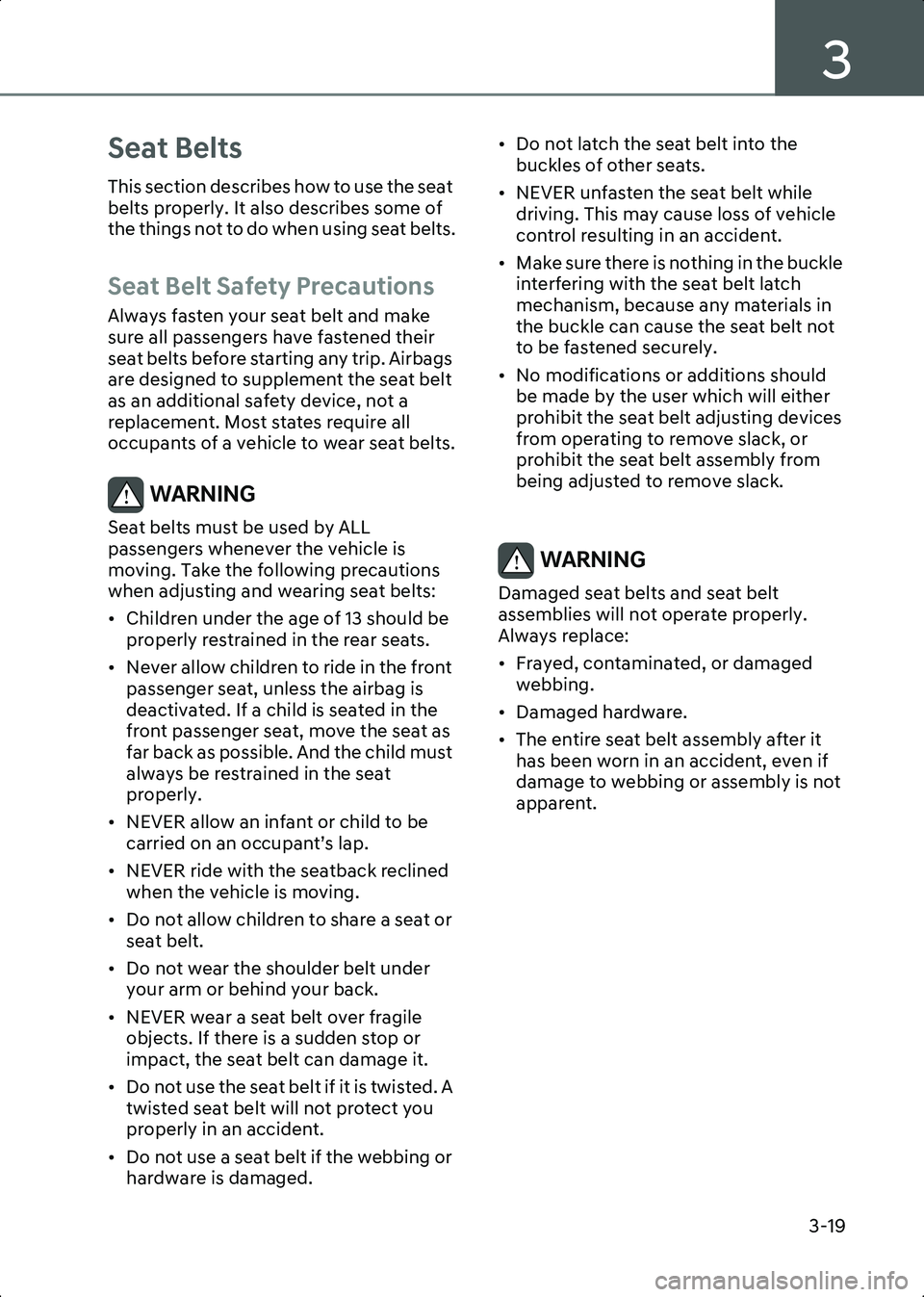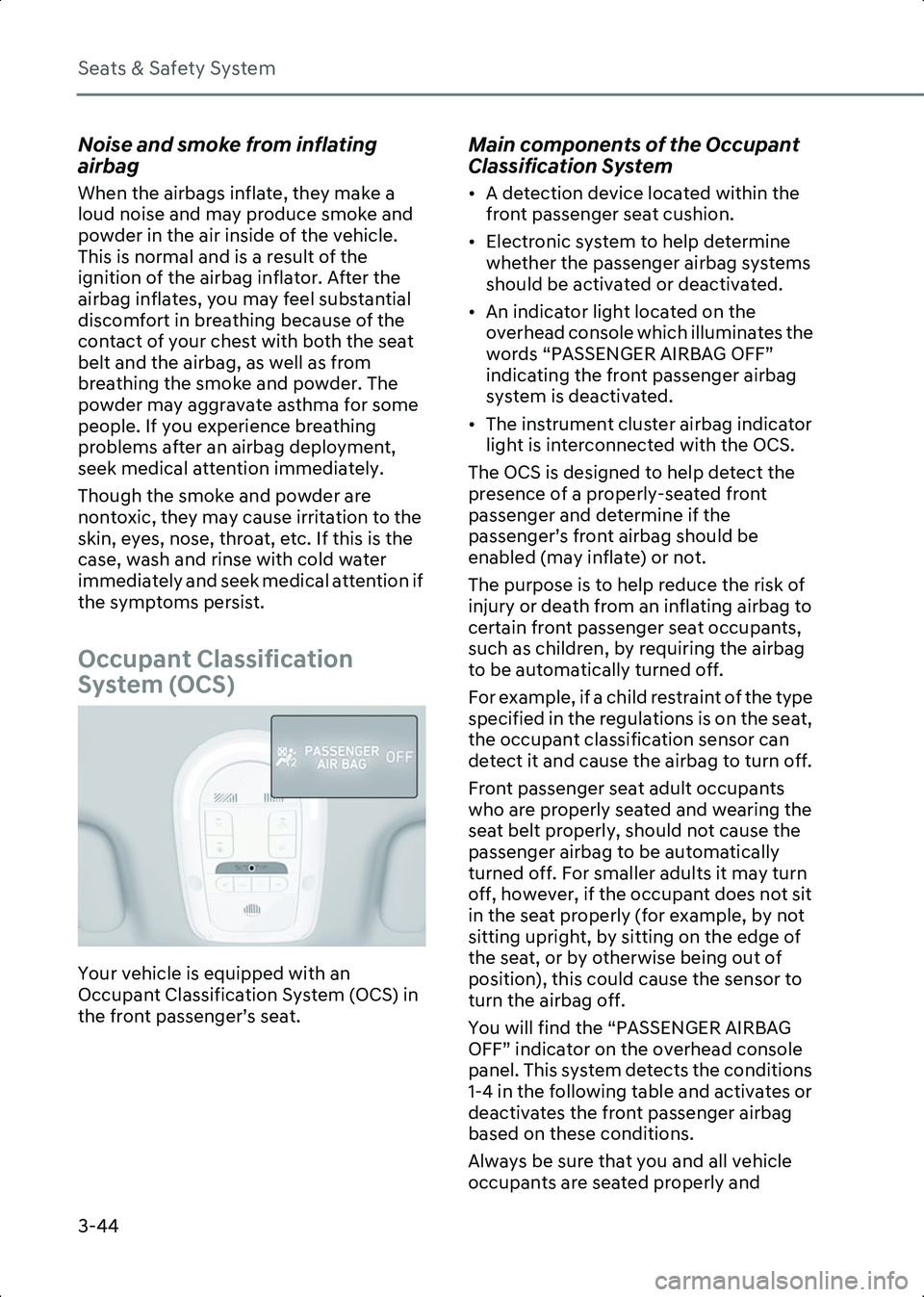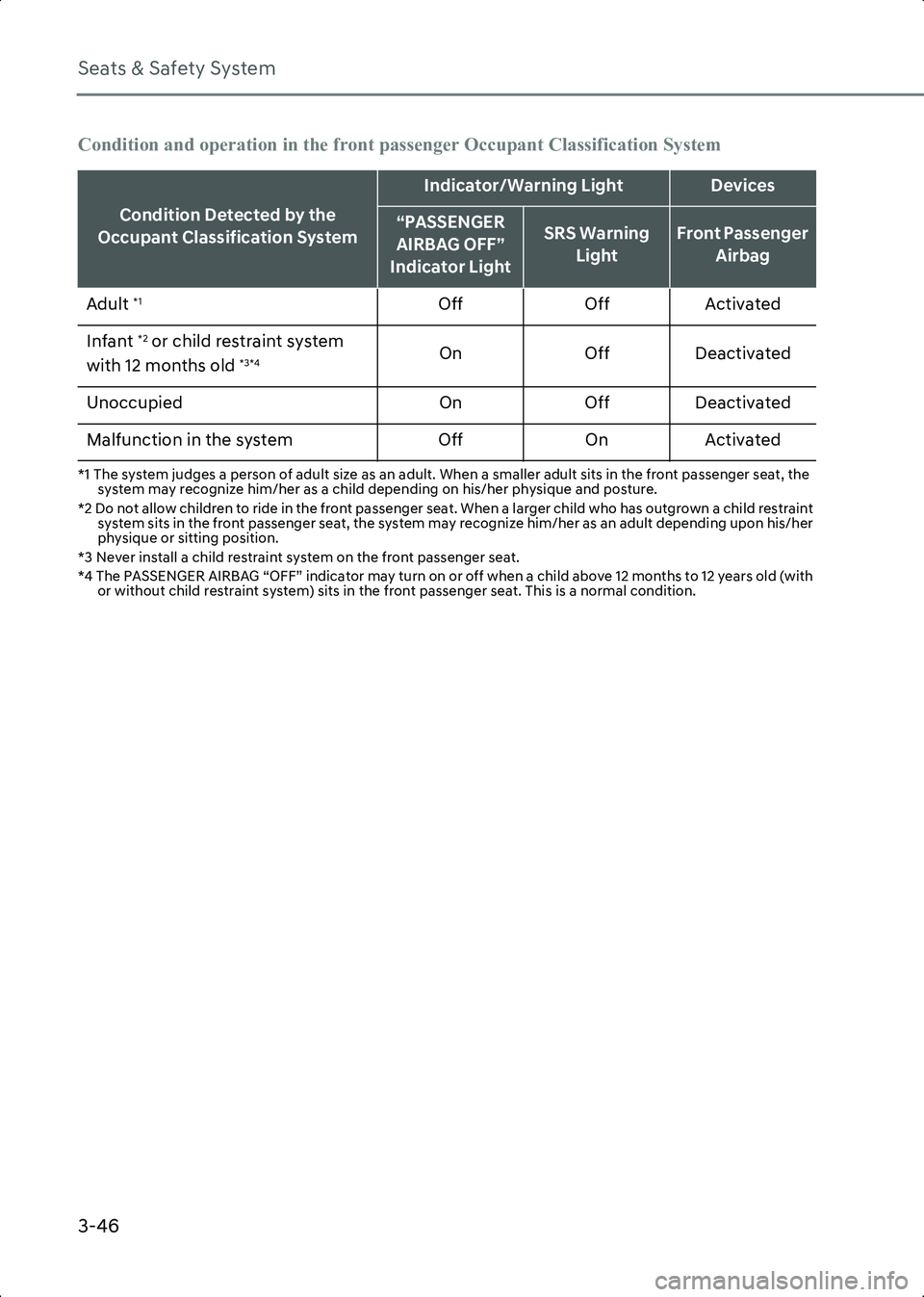2023 HYUNDAI IONIQ 6 deactivate passenger airbag
[x] Cancel search: deactivate passenger airbagPage 113 of 582

3
3-19
Seat Belts
This section describes how to use the seat
belts properly. It also describes some of
the things not to do when using seat belts.
Seat Belt Safety Precautions
Always fasten your seat belt and make
sure all passengers have fastened their
seat belts before starting any trip. Airbags
are designed to supplement the seat belt
as an additional safety device, not a
replacement. Most states require all
occupants of a vehicle to wear seat belts.
WARNING Seat belts must be used by ALL
passengers whenever the vehicle is
moving. Take the following precautions
when adjusting and wearing seat belts:
• Children under the age of 13 should be properly restrained in the rear seats.
• Never allow children to ride in the front passenger seat, unless the airbag is
deactivated. If a child is seated in the
front passenger seat, move the seat as
far back as possible. And the child must
always be restrained in the seat
properly.
• NEVER allow an infant or child to be carried on an occupant’s lap.
• NEVER ride with the seatback reclined when the vehicle is moving.
• Do not allow children to share a seat or seat belt.
• Do not wear the shoulder belt under your arm or behind your back.
• NEVER wear a seat belt over fragile objects. If there is a sudden stop or
impact, the seat belt can damage it.
• Do not use the seat belt if it is twisted. A twisted seat belt will not protect you
properly in an accident.
• Do not use a seat belt if the webbing or hardware is damaged. • Do not latch the seat belt into the
buckles of other seats.
• NEVER unfasten the seat belt while driving. This may cause loss of vehicle
control resulting in an accident.
• Make sure there is nothing in the buckle interfering with the seat belt latch
mechanism, because any materials in
the buckle can cause the seat belt not
to be fastened securely.
• No modifications or additions should be made by the user which will either
prohibit the seat belt adjusting devices
from operating to remove slack, or
prohibit the seat belt assembly from
being adjusted to remove slack.
WARNING Damaged seat belts and seat belt
assemblies will not operate properly.
Always replace:
• Frayed, contaminated, or damaged webbing.
• Damaged hardware.
• The entire seat belt assembly after it has been worn in an accident, even if
damage to webbing or assembly is not
apparent.
Hyundai_CE_en_US.book Page 19
Page 131 of 582

3
3-37
WARNING AIRBAG SAFETY PRECAUTIONS
ALWAYS use seat belts and Child
Restraint Systems - every trip, every time,
everyone! Even with airbags, you can be
seriously injured or killed in a collision if
you are improperly belted or not wearing
your seat belt when the airbag inflates.
NEVER place a child in any Child Restraint
System or booster seat in the front
passenger seat, unless the airbag is
deactivated.
An inflating airbag could forcefully strike
the infant or child causing serious or fatal
injuries.
ABC - Always Buckle Children under age
13 in the back seat. It is the safest place for
children of any age to ride. If a child age 13
or older must be seated in the front seat,
he or she must be properly belted and the
seat should be moved as far back as
possible.
All occupants should sit upright with the
seatback in an upright position, centered
on the seat cushion with their seat belt on,
legs comfortably extended and their feet
on the floor until the vehicle is parked and
the vehicle is turned off. If an occupant is
out of position during an accident, the
rapidly deploying airbag may forcefully
contact the occupant causing serious or
fatal injuries.
You and your passengers should never sit
or lean unnecessarily close to the airbags
or lean against the door or center console.
Move your seat as far back as possible
from front airbags, while still maintaining
control of the vehicle. The U.S. National
Highway Traffic Safety Administration
(NHTSA) recommends that drivers allow
at least 10 in. (25 cm) between the center
of the steering wheel and the chest.
Where are the Airbags?
Driver’s and passenger’s front
airbags
Driver’s front airbag
B3002801Passenger’s front airbag
B3003001
Your vehicle is equipped with a
Supplemental Restraint System (SRS) and
lap/shoulder belts at both the driver and
passenger seating positions.
The SRS consists of airbags which are
located in the center of the steering
wheel and the passenger’s side front
panel pad above the glove box.
The airbags are labeled with the letters
“AIRBAG” embossed on the pad covers.
The purpose of the SRS is to provide the
vehicle’s driver and front passengers with
additional protection than that offered by
the seat belt system alone in case of a
frontal impact of sufficient severity.
The seat belt buckle sensors determine if
the driver and front passenger's seat belts
are fastened. These sensors provide the
Hyundai_CE_en_US.book Page 37
Page 138 of 582

Seats & Safety System
3-44
Noise and smoke from inflating
airbag
When the airbags inflate, they make a
loud noise and may produce smoke and
powder in the air inside of the vehicle.
This is normal and is a result of the
ignition of the airbag inflator. After the
airbag inflates, you may feel substantial
discomfort in breathing because of the
contact of your chest with both the seat
belt and the airbag, as well as from
breathing the smoke and powder. The
powder may aggravate asthma for some
people. If you experience breathing
problems after an airbag deployment,
seek medical attention immediately.
Though the smoke and powder are
nontoxic, they may cause irritation to the
skin, eyes, nose, throat, etc. If this is the
case, wash and rinse with cold water
immediately and seek medical attention if
the symptoms persist.
Occupant Classification
System (OCS)
B3003102
Your vehicle is equipped with an
Occupant Classification System (OCS) in
the front passenger’s seat.
Main components of the Occupant
Classification System
• A detection device located within the front passenger seat cushion.
• Electronic system to help determine whether the passenger airbag systems
should be activated or deactivated.
• An indicator light located on the overhead console which illuminates the
words “PASSENGER AIRBAG OFF”
indicating the front passenger airbag
system is deactivated.
• The instrument cluster airbag indicator light is interconnected with the OCS.
The OCS is designed to help detect the
presence of a properly-seated front
passenger and determine if the
passenger’s front airbag should be
enabled (may inflate) or not.
The purpose is to help reduce the risk of
injury or death from an inflating airbag to
certain front passenger seat occupants,
such as children, by requiring the airbag
to be automatically turned off.
For example, if a child restraint of the type
specified in the regulations is on the seat,
the occupant classification sensor can
detect it and cause the airbag to turn off.
Front passenger seat adult occupants
who are properly seated and wearing the
seat belt properly, should not cause the
passenger airbag to be automatically
turned off. For smaller adults it may turn
off, however, if the occupant does not sit
in the seat properly (for example, by not
sitting upright, by sitting on the edge of
the seat, or by otherwise being out of
position), this could cause the sensor to
turn the airbag off.
You will find the “PASSENGER AIRBAG
OFF” indicator on the overhead console
panel. This system detects the conditions
1-4 in the following table and activates or
deactivates the front passenger airbag
based on these conditions.
Always be sure that you and all vehicle
occupants are seated properly and
Hyundai_CE_en_US.book Page 44
Page 140 of 582

Seats & Safety System
3-46
Condition and operation in the front passenger Occupant Classification System
*1 The system judges a person of adult size as an adult. When a smaller adult sits in the front passenger seat, the system may recognize him/her as a child depending on his/her physique and posture.
*2 Do not allow children to ride in the front passenger seat. When a larger child who has outgrown a child restraint system sits in the front passenger seat, the system may recognize him/her as an adult depending upon his/her
physique or sitting position.
*3 Never install a child restraint system on the front passenger seat.
*4 The PASSENGER AIRBAG “OFF” indicator may turn on or off when a child above 12 months to 12 years old (with or without child restraint system) sits in the front passenger seat. This is a normal condition.
Condition Detected by the
Occupant Classification System
Indicator/Warning LightDevices
“PASSENGER AIRBAG OFF”
Indicator LightSRS Warning LightFront Passenger Airbag
Adult
*1Off OffActivated
Infant
*2 or child restraint system
with 12 months old *3*4On Off Deactivated
Unoccupied OnOff Deactivated
Malfunction in the system OffOnActivated
Hyundai_CE_en_US.book Page 46